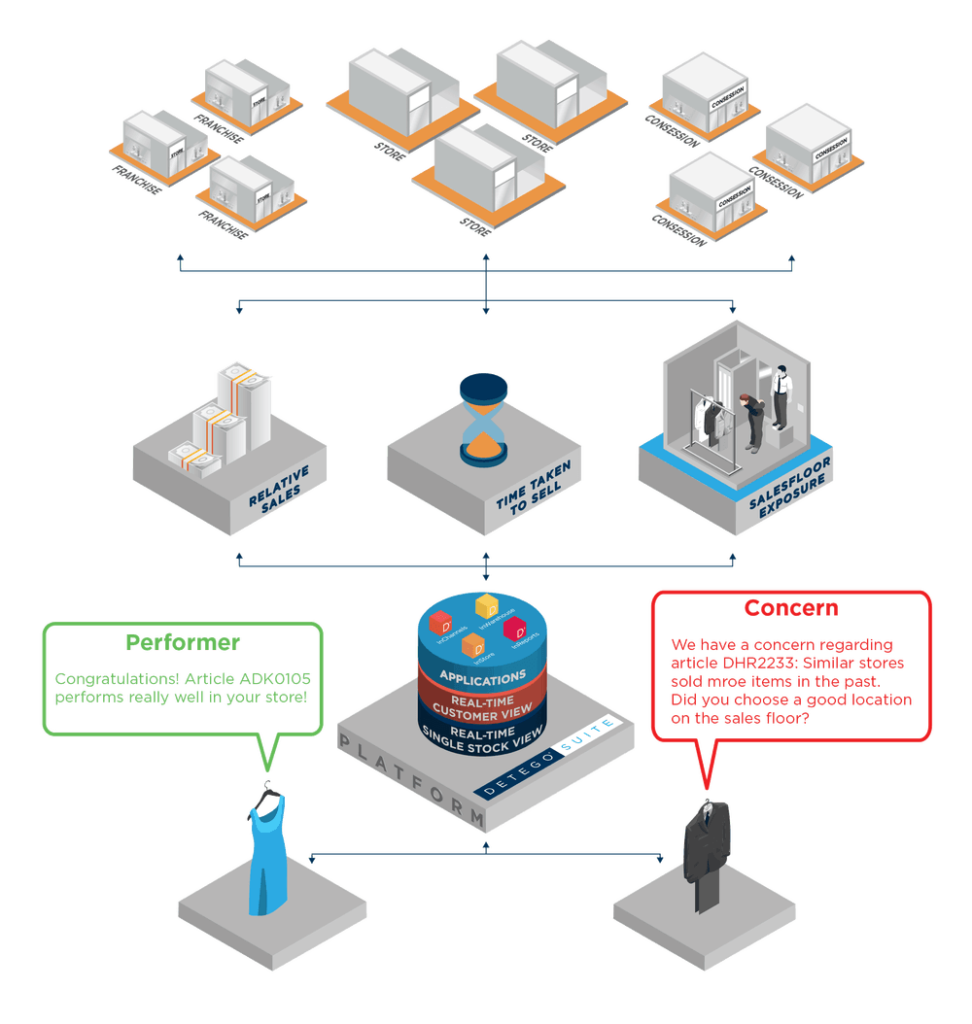Inventory analytics in the cloud

The hype about cloud-based systems continues: There is hardly a software system that has not stepped into the cloud. Many applications, especially in the business environment, rely on an “infrastructure-as-a-service” or “platform-as-a-service” model, where existing solutions are simply hosted and operated by a large cloud provider.
In addition, there are true “software-as-a-service” solutions that are available for a monthly fee with guaranteed performance.
Regardless of the actual model chosen, the cloud offers enormous advantages for retail companies, especially with respect to RFID-based inventory management.
Advantages of inventory analysis in the cloud
- IT infrastructure does not have to be operated and maintained by the retailer: Focus on core business
- Lower costs: in comparison to individual operations
- Flexibility: For store openings and closings, and even for the operation of pop-up stores
- Easier integration with existing systems: standardised, open APIs
Smart processing of data at scale
Compared to traditional inventory management, an RFID-based approach brings one thing in particular from a system perspective: More data. Frequent, even permanent and real-time stock takes and tracking of each individual article movement generates more data than before. More data is not necessarily an advantage, and must be processed and stored somewhere. In addition to the – almost unlimited – storage space that cloud-based systems offer, here is another decisive advantage: On one hand, sufficient computing capacity is available for complex and -intensive processing steps, which can be activated simply and automatically “when needed” (“scaling up” and “scaling out”). On the other hand, in cloud-based systems, the application of modern algorithms such as machine learning methods are significantly simplified in order to actually benefit from operational data.
What does data reveal?
This gives retailers access to a broad portfolio of analytic tools, algorithms and necessary infrastructure, without having to become a specialist in the implementation and operation of complex systems and tools for large-scale data analysis. Sounds abstract? The following examples show concrete use cases:
Analysis of the performance of individual articles:
While classical analysis is mostly limited to sales data, new technologies allow far deeper insight into what is happening in the store. With RFID-based inventory management, in addition to sales data, other parameters can be precisely measured and correlated. Derived from this, influencing factors are used to determine in which store the sales probability for certain articles is actually the highest. What is the result of the analysis? Easy to follow recommendations for the sales personnel in the store in order to make the most of the potential of the sales area. Sales personnel receives notifications directly on the smartphone which is processed as soon as possible.
Raw data from the store network – Derive meaningful KPIs – Processing and feedback to the store
Evaluation of periodic inventory data:
The classical stocktake: Not very popular, cumbersome and lengthy – still needs to be done 1-2 times per year for audit purposes. However, an RFID-based system makes it very easy. Reason enough to increase the frequency for better data accuracy. This quickly results in several thousand data records per year. Nevertheless, these datasets contain far more information than just the ordinary inventorydifferences that need to be accounted for in the ERP system: A targeted analysis quickly identifies trends about problematic items, allowing timely countermeasures. As far as the operational process is concerned, smart algorithms can raise additional potential: The classic approach of “one RFID-based stocktake per week” is not necessarily optimal or necessary in every store. Detego InReports suggests the ideal time for a stocktake and can even predict how many people will be needed to complete the process in the desired time. It provides support where it makes sense.
These scenarios show how current methods and algorithms from the world of data analysis, when cleverly applied to inventory data, can show operational benefits.
While this might sound simple, practical implementation is far from easy due to the amount of data that needs to be processed and complexity of procedures used.
Specialized systems that leverage benefits of the cloud can help address this and gain data driven insights rather than pure intuition. This is accessible in a scalable infrastructure that comes with predictable cost within a simple SaaS model.
What needs to be taken into consideration by retailers
Aside from all the advantages, there are also aspects in the use of cloud-based systems, which requires rethinking and possibly even making changes to the existing infrastructure.
Infrastructure
Make sure your infrastructural equipment is bandwidth-rich to enable you to run store applications in the cloud with satisfactory performance and to adequately size Internet uplinks for today’s and tomorrow’s applications.
Data collection in the store
Make sure to install optimal WIFI in your stores. That is what customers expect nowadays. Not only do customers interact with their smartphone while shopping, persons accompanying them do so too. That is an aspect which should not be underestimated in order to keep customers in the store and offer new services.
„Shared“ versus „Dedicated“-Cloud-environments
Many software packages allow operation either in a so-called “shared environment” where resources are shared with other companies, or in a “dedicated environment” which is operated exclusively for a particular customer. Both variants have their advantages and disadvantages. While “shared environments” are generally cheaper to operate, there are some dependencies, e.g. in terms of performance. “Dedicated environments” usually offer more flexibility but also entail higher costs.
Lock-In to a Cloud-Provider
Cloud software packages that can be transferred at any time from one cloud to another if necessary are advantageous. This bypasses a long-term dependency on one of the classic cloud providers, e.g. Amazon, Google, Microsoft and Co. It is recommended to make sure that the software you use is not dependent on a particular provider, but can also be operated flexibly with another provider.
Conclusion
Your inventory data contains information going far beyond the typical inventory differences or what ordinary sales data can tell you. Smart analytics and state-of-the-art processing helps you to unlock this potential – a new way where cloud-based systems flex their muscles.

